Secrets of The Beatles
The Beatles songs provide a rich resource for analysis. The song writing styles of John Lennon and Paul McCartney not only differ from each other fundamentally, but also change over time, affected and influenced by each other. Using SeeChord we can really highlight the differences between the two, and find out exactly how to write that killer sequence!
You might also be interested in finding out the Secrets of the Top 20 songs of all time, or listening to some Music Theory Podcasts.
If you have not used SeeChord before, it may be helpful to watch this short tutorial first.
Follow the songs chronologically or choose a song from the following list:
McCartney songs:
And I love her Yesterday Yellow Submarine Eleanor Rigby Here there and everywhere Sargent Pepper Hey Jude Helter Skelter Blackbird Let it be The long and winding road
Lennon songs:
Help Day Tripper Ticket to ride Norweigan wood Nowhere man And your bird can sing Strawberry Fields Lucy in the sky with diamonds For the benefit of Mr. Kite A day in the life All you need is love I am the walrus Happiness is a warm gun Imagine The long and winding road
All the songs that follow are accompanied by a SeeChord chart of an excerpt from the song, some of my insights into the chord sequence of that particular Beatles song and an audio clip played by myself of the clip you are seeing.
McCartney
And I love her(1964)
A classic example of Paul’s early output. Look at the simple chord changes from f minor to c minor before the wonderfully classical move to the relative major (Ab)
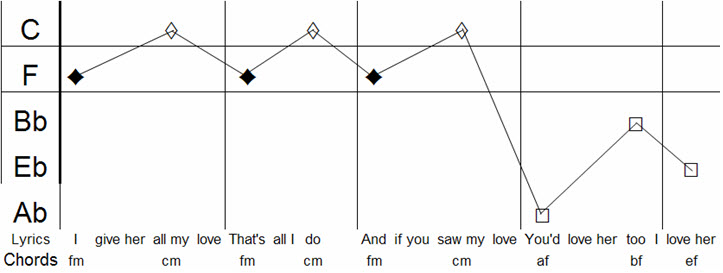
Paul McCartney had a classical music training and this often comes out in his chord progressions. Here is the same progression from “And I Love Her” seen in a Bach Prelude.

A nice example of how The Beatles used chord progressions to highlight their lyrics. It is nice to resolve onto a major key with the words “I love her”. It provides a sense of well-being and happy resolution after the minor dithering earlier.
Yesterday(1965)
Just the most wonderful song, but what makes it work so well? Below is the SeeChord chart of the very start of the song and we can see straight away an audacious jump from F to eminor. This can only possibly work if the music then falls down in fifths after that, which of course it duly does. Looks like Paul McCartney knew how to handle a difficult chord progression.
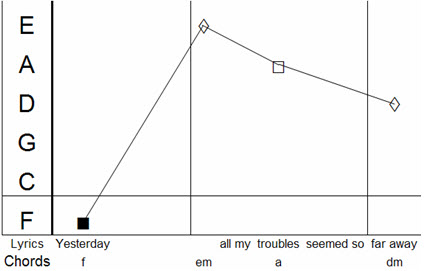
This is in fact a common jump from F to emin(chromatic descending), but unusual so early in a progression. Look at the wonderful snaking falling fifths progression right back to F again…
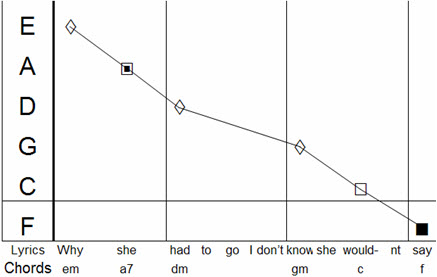
Classic use of the descending fifths progression in the bridge here. This leads the ear to the root chord of F, giving a very satisfying sound when we get there.
Yellow Submarine(1966)
Wonderfully simple, daringly irreverent, Yellow Submarine is the most unlikely of classics yet it endures to this day. Nothing to write home about in the chord progressions, just a good example of solid son writing
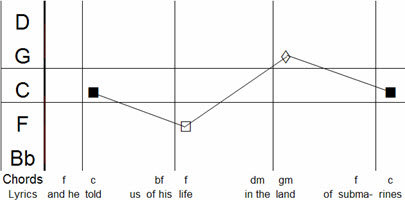
Perhaps the most common chord progression of all time in the most common key of all time? C-F-G-C (I-IV-V-I) is the basis for countless songs, either on a small scale over a few bars, or over the course of a whole song.
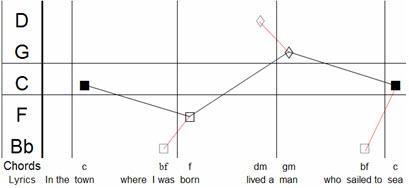
However, this example shows the auxiliary chords that appear on the fourth beat of every bar in the verse, which adds a layer of complexity. For those who are interested, the use of the B flat chord gives the piece a modal (mixolydian) feel at the start, which then resolves in the chorus by moving into F. The chorus is C and F…that’s it!
Eleanor Rigby(1966)
Status Quo may get a hard time for their simple chord progressions but this wins every time. Such a beautiful song, such simple chords!

Well, there you have it! The entire song consists of two chords. E minor and C major. There are some resultant harmonies that emerge from the descending notes in “I look at all the lonely people”, but the fundamental harmony remains the same. I suppose that this restriction leads to the drudging and faintly depressing tone to the song, backed up by the insistent string parts.
Here There and Everywhere(1966)
In many ways, the opposite of Eleanor Rigby in that it is rich and complex harmonically speaking. The first time Paul really spreads his compositional wings and takes bigger risks.
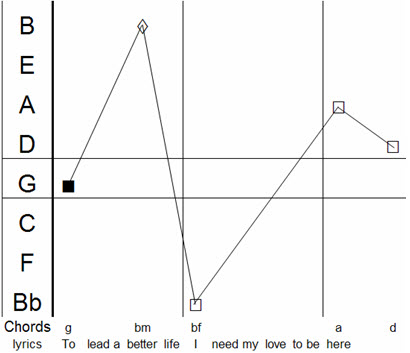
Ok, this is pretty out there really for Sir Paul. The B flat is really as out of place as it looks. It is a chromatic fall from B through to Bb through to A, but that’s still no excuse. It is a beautiful piece of writing and a fine example of imaginative use of chords in a progression.
For those who are interested, the Bb could be explained away as a tritone substitution for E, which would fit neatly into our falling fifths progression. However, there is no concession to this by means of a flat 5 so it remains a truly chromatic progression.
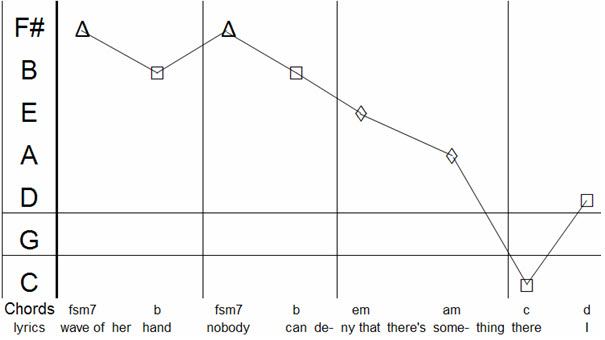
This is a fine example of a gentle meandering fall through fifths to get back towards the root note (G). It is a good tip that you can get away with almost any jump up the chart, but it’s always best to come down slowly!
Sgt. Pepper(1967)
Firmly into the next phase of The Beatles output and a true rock progression here.
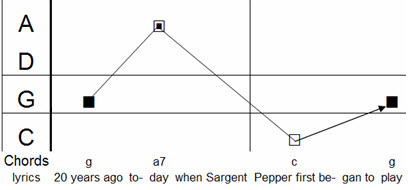
This is the basic chord progression that recurs throughout the song. It is worth noting that the D7 chord is often avoided, with the C or C7 played instead. Just like in Helter-Skelter, this gives the song that rocky, edgy feel.
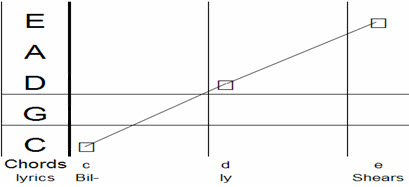
This stunningly unusual ending takes us into “I get by”. It is a real cheat to get from C to E just by stepping up through D. Perhaps he should have taken note of his beautiful chord progressions in blackbird and gone C-A7-D-B7-E?
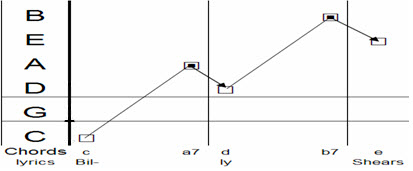
Who am I to suggest changes to Beatles songs but this would have been more harmonically pleasing!
Hey Jude(1968)
Another great example of keeping it simple to make a hit. And the hits don’t get much bigger than this.
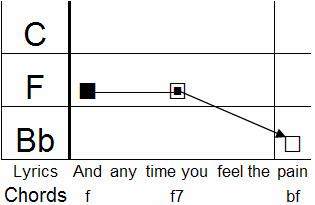
This is the moment we launch into the chorus. This chart shows the strong use of the V-I progression (F7-Bb).

Here we see the same strong V-I progression to get us back to the verse. This seems a little forced, and is added as an extension to the chorus. The C7 is really only there to give a sense that we have arrived back in the original key of F, even though we were there at the end of the chorus anyway!
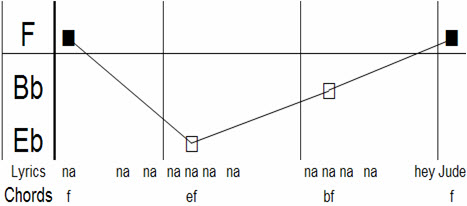
This is the singalong end. It is surprisingly unconventional as we can see the chords dropping from F to Eb and then rising back up again. Usually we would expect the chords to jump up and then fall back down. This kind of pattern represents falling fourths. (Eb-Bb-F).
Further Analysis
Nothing really unconventional which makes this an instantly memorable hit!
Verse (F)
No surprises here, just using F, Bb and C to establish key. The second verse has an extension at the end of F7 which takes us into the chorus with a strong progression.
Chorus(Bb)
Slightly unusual to start on Bb, but the progression is simple and ends on F. At the end another extension uses C7 to take us back to the verse with the same V-I progression (perfect cadence) as was used in the transition from verse to chorus.
Outro(F)
The famous singalong outro is actually a little unusual in that it falls down to Eb and then rises back up through the fifths to F again
Helter Skelter(1968)
I am continually stunned by how rocky this track is. It could easily be a Led Zeppelin track. Proof, if need be, that The Beatles were the masters of genre and could stand up against any of their peers.


The introduction here is interesting for the fact that we seem to have arrived at G by means of C (IV-I), but immediately jump off to E again.

The extract from the chorus above shows a complete avoidance of the B chord (V) which is unusual in a piece so obviously bluesy in style. Also unusual for Paul not to use the V-I progression in one of his tunes. It gives the piece a gritty, true rock feel.
Blackbird(1968)
Heart-breakingly beautiful and with an exquisite chord progression to back it up.
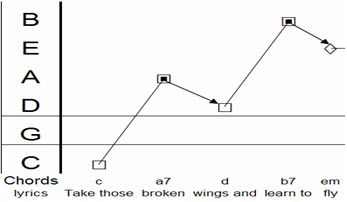
Here we see a very elegant way of rising up the chart from C to B using a series of V-Is (A7-D and (B7-E). Often in this situation we would see a jump straight from C to B and then the fall back down, but this is far more sophisticated.
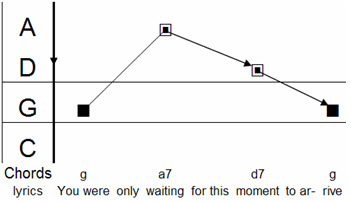
Here is the resolution of the meandering chords of the verse. It is as conventional as it gets which closes the verse with authority.
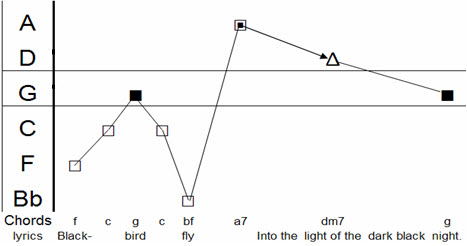
This is the end of the chorus. Again we can see unconventionality in the for of the Bflat chord (the lowest point of the chart), followed by a conventional finish. It would seem that if you are going to be experimental in your progressions, it is best to do it early, and then finish strongly!
Let it Be(1970)
It’s the four-chord song. I-V-vi-IV. Never fails…

So simple that I have shown the complete chart. Only four chords used as can be seen. The main point of interest would be the end of the verse and chorus which rises from F to C (IV-I) rather than using the more common G to C (V-I or perfect cadence). Sometimes the IV-I progression is said to have religious overtones as it is used to end many sacred pieces.
LENNON
Help(1965)
Immediately we see Lennon’s use of harmony is less conventional and more daring. Right back in 1965 he is stretching his musical muscles and finding elegant chord progressions. Nothing totally out there yet though.
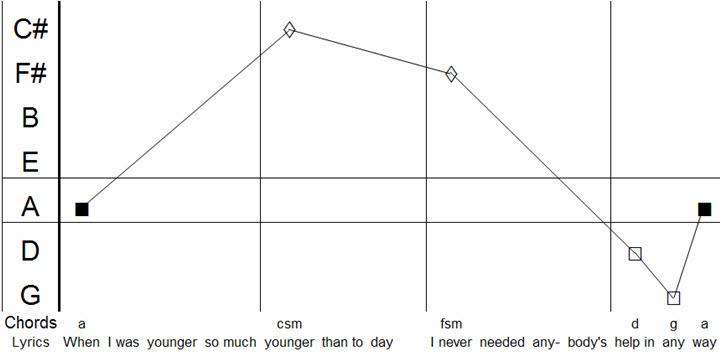
We see again though the tendancy to avoid the V-I (E-A) progression, favouring the IV-I (D-A) or in this case even D-G-A instead. The predictable chord sequence here would be A-C#m-F#m-B-E-A, which fits the tune perfectly.
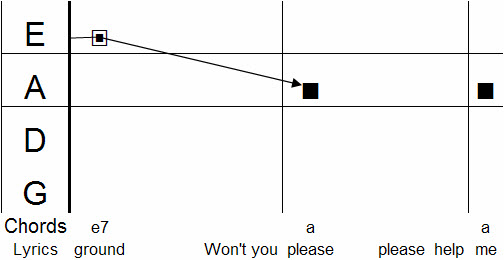
At last! (E7-A) a perfect cadence.
Day Tripper(1965)
Again we are in truly explorational territory here. Sometimes it is hard to appreciate the forward thinking of John Lennon’s songwriting as his songs are so familiar, however most of his writing was without precedent at the time.
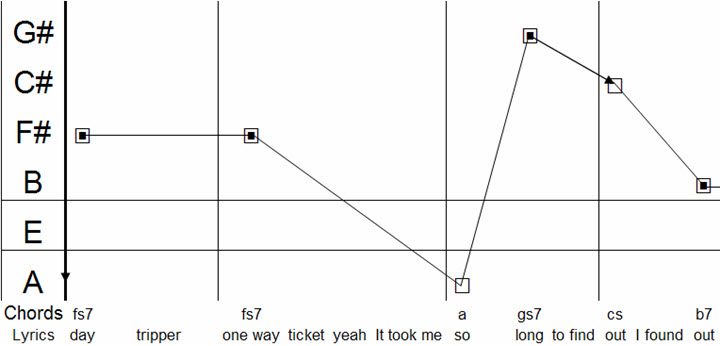
Although this starts with a traditional blues progression, and in the traditional blues key of E, Lennon’s creativity soon creates this startling sequence above. It is such a familiar tune that I struggle to hear the unconventionality of this passage, strangely reminiscent of the extracts from Mr Kite?!
Ticket to ride
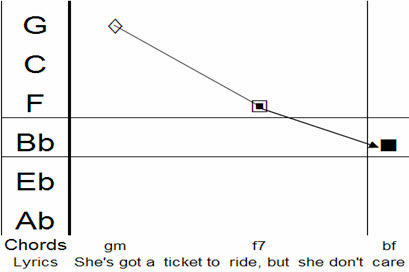
A conventional F-Bb (V-I) ending to the verse…must have been an early work!

Again the chorus to verse is as expected with F-Bb.
Norwegian wood
Pushing the envelope even further here with a major-minor change mid song.

This is the chart of the entire song. We can see the classic Lennon writing style of using the IV-I or IV of IV-I (D-E) in the verse, and then getting back to the verse from the end of the chorus with a V-I (B-E).
Nowhere man
A slightly more conventional use of harmony sticking mainly to the I-IV-V chords.

Well, why would you use the sequence Eb-Ab-Bb-Eb, when you could turn it around and have the Lennon special Eb-Bb-Ab-Eb? Yet again, the ubiquitous V-I (Bb-Eb) is either not there at all, or in this case, saved for the link from the end of the chorus back to the verse.
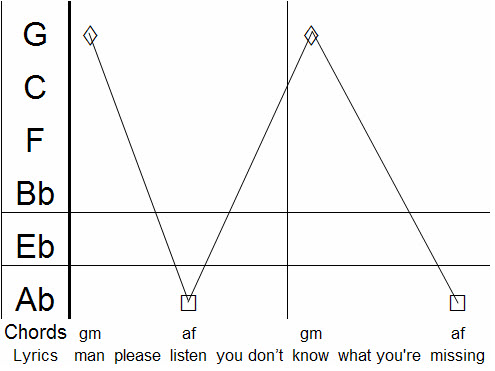
Interesting chromaticism here from the Gm to Ab.
And your bird can sing
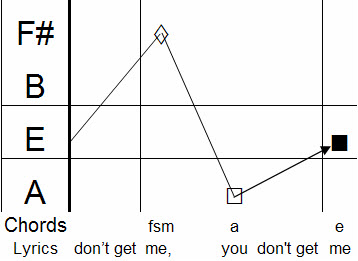
Here we see the end of the first phrase of the verse. The A-E (IV-I) is interesting as we might expect B-E (V-I). This could be analysed as a substitution, in other words, if you have a V-I cadences or ending in your song, try substituting the V for a IV!
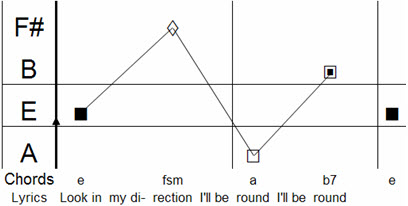
This is the end of the chorus which was in the relative minor of G sharp, back into the verse. Here we can see the B7-E (V-I) which is the strongest way back to the root note or E. Generally speaking, a highly conventional progression with very few surprises.
Strawberry fields

This little sequence says a tremendous amount about Lennon’s writing. Jumps up or down a third (Eb-G-Eb), and the IV-I cadence (Eb-Bb).
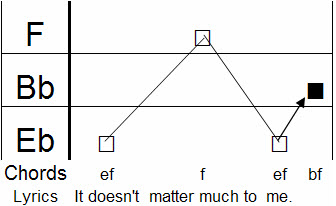
Out of interest, the extract above is the end of a verse which is startlingly reminiscent of the end of the chorus, and in fact the ends of most of Lennon’s verses.
Lucy in the sky with diamonds

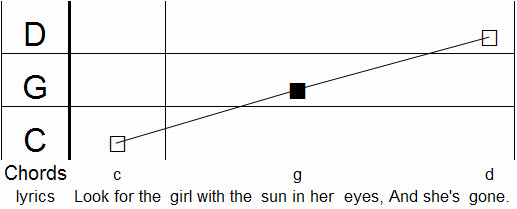
A nice lilting start, oscillating between two chords in a 3 in the bar feel. Much like being on a river funnily enough.
I suppose I should be expecting this by now with Lennon’s writing, but it still comes as a surprise that he manages to avoid the V-I (D-G), and yet the music works so well. At least the D at the end of this extract does lead into the chorus in G. From there the chorus is quite conventional using G, C and D.
Benefit of Mr. Kite
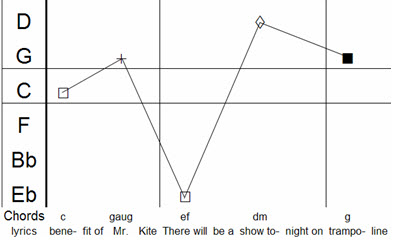
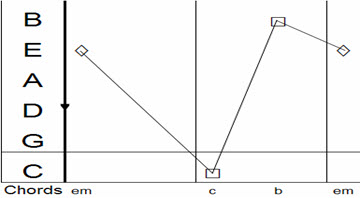
Very anarchic chord structure in this song to go with the feel of the lyrics and arrangement. Interesting though that these extracts, the first from the verse, the second from the instrumental are identical. We must only guess as to whether this was incidental, arising from the genius of John Lennon’s cohesive writing style, or a carefully thought out imitation.
A Day in the life
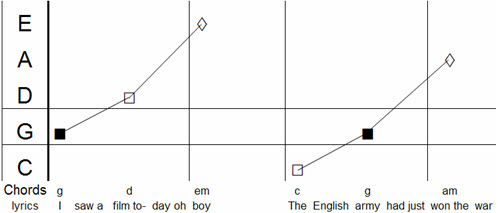
This is John’s song and we see some unresolved progressions here. The phrases are left hanging, although many of the harmonies are resulting from the descending bassline.

Paul’s turn now and the chords are very conventional for his song. However, he then jumps in with the Ahs with the longest string of descending fourths (seen as a rising line) I have ever seen. Utterly unconventional. Also worth noting is the fact that there is not a single minor chord in the whole of his song!
All you need is love

An odd phrase that hangs unresolved on the E minor chord for 3 beats rather than the usual 4. This is a phrase that needs careful completion to bring it a sense of structure.

This is the resolution of the phrase, and indeed it is traditional in the sense that the chords are closely related, and that the final chord (D) leads to the first chord of the chorus (G) with the strongest possible progression (V-I).
I am the walrus
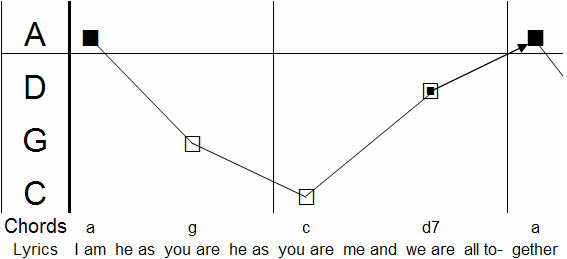
Typical Lennon writing here as we avoid the E chord once more that would take us nicely to A. Also unconventional in the use of chords below the root position on the chart. G major and C major are not usually in the family of chords you would use in A major!

It’s weird, it also happens to be exactly the chords in Sargent Pepper for “Billy Shears”. Musically speaking it breaks all the rules in one hit.
Happiness is a warm gun

This song is really characterized by its continually shifting and irregular time signatures. The chords remain fairly simple. It is worth noting that the only time the E chord is used is right at the beginning in the extract above.
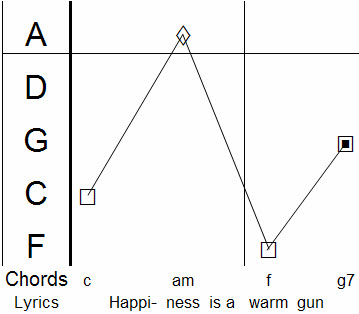
This is the riff that carries the last part of the song. It is a very common chord sequence (you will hear it bashed out on school pianos across the country!)
Imagine

Two chords are all you need for a classic! What this does is heighten the moment when we move away from these chords.
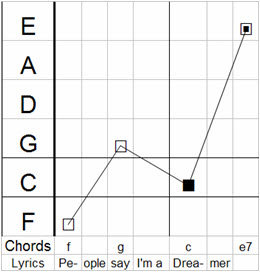
This is the structure in the chorus that is repeated four times. The E chord looks out of place, and indeed it is very unusual. The song would not sound vastly different if the E was not there at all, but of course, its that extra touch of genius that makes the difference.
Further Analysis
Very unusual reliance on just two chords, C and F for most of the verse. When it breaks, we see the classis falling fifth pattern, but not landing on the key note, instead skipping to F at the start of the chorus. The chorus repeats the same pattern with the surprising inclusion of the E7 chord which provides a series of “interrupted” cadences that never resolve to A where we would expect.
BOTH
The Long and winding road
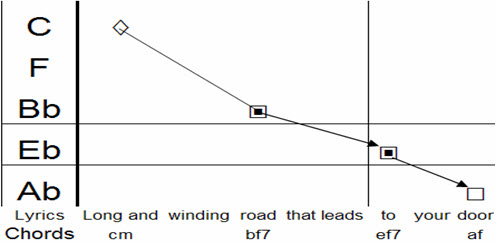
Very strange start to the verse as can be seen. It takes until the third bar to really rest on the root note of Eb. Although we can see a familiar falling fifths pattern it skips F and shoots straight past the Eb.
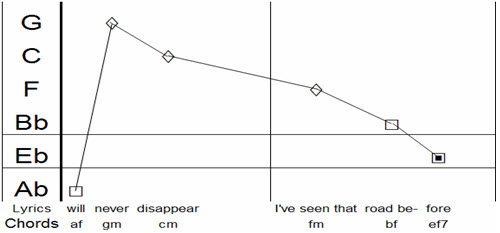
Immediately following from the previous chart we see this classic pattern of falling fifths with the jump from Ab to G at the start. Strangely reminiscent of a long and winding road?! This progression is the strongest available and is likely to sound satisfying and well constructed.
Further analysis
Verse(Eb)
An unsettling intro, not starting on the root note (Eb), but on the relative minor. In fact the movement does not settle on the root note until the end of the verse, giving a sense of suspense and then resolution on “lead me to your door”.
Chorus(Eb)
Far more conventional and smacking of McCartney’s solo works such as Pipes of peace. Gives a balancing grounded feel to the chorus.
Conclusions
It is interesting to note here the difference in chord writing from Lennon and McCartney. While McCartney seems ever tied to the more conventional chord progressions, lending his songs to a sing-a-long success, John’s are more complex and inventive. John’s songs show some hallmarks of being composed almost entirely by ear, in other words, by playing music and seeing what sounds good. Paul’s songs seem to be based more on hooks and formulaic song writing techniques.